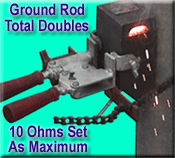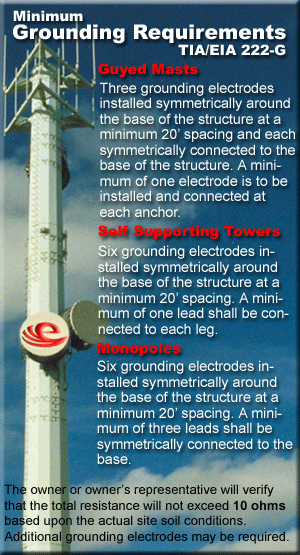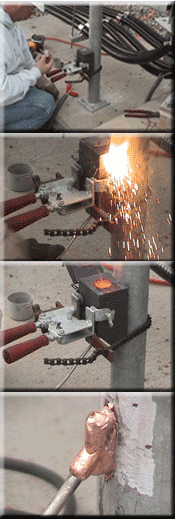|
Protective grounding standard  introduced in Revision G With the introduction of Revision G of the ANSI/TIA 222 standard for antenna supporting structures and antennas, effective January 1, 2006, the standard for protective grounding has increased the minimum number of ground rods required and has set a maximum number of ohms of total ground resistance. introduced in Revision G With the introduction of Revision G of the ANSI/TIA 222 standard for antenna supporting structures and antennas, effective January 1, 2006, the standard for protective grounding has increased the minimum number of ground rods required and has set a maximum number of ohms of total ground resistance.
Ground rod quantity increases
In Revision F the minimum number of ground rods specified for a self supporting structure totaled three; the new standard requires six grounding electrodes. Guyed structures saw an increase from two to three rods at the base. As in Revision F, the new standard requires a ground rod at each anchor.
Monopoles were added to Revision G and require six ground rods installed symmetrically around the base of the structure with a minimum 20' spacing between each one. A minimum of three leads must be attached symmetrically to the base.
Ten ohms set as maximum
The new standard also addresses ground resistance values, stating that the owner will verify that the total resistance will not exceed 10 ohms. A resistance level had not been previously identified. Some site specifications require a maximum of 4 ohms. The total resistance of the structure's primary grounds as referenced to remote earth should be measured or calculated in accordance with the Institute of Electrical and Electronics Engineers (IEEE) Standard 142-1991, the standard states.
Ten foot rods set as minimum
The previous revision identified that the minimum ground rod should be a 5/8" diameter galvanized steel rod with a lead of not smaller than #6 tinned bare copper wire. The new standard requires the electrodes, as a minimum, to be 5/8"x10' metal rods constructed of copper, copper clad steel, galvanized steel or stainless steel alloy. The minimum embedment depth of the rods must be 10'. All electrodes must be electrically connected to the structure; however, all electrodes need not be interconnected, according to Rev G.
The standard cautions that for soils with resistivities less than 50 ohm-m, copper or copper plated grounding electrodes may contribute to galvanic corrosion. Under these conditions it is stated that grounding electrodes may be replaced by grounding anodes or other corrosion control methods. The grounding standards also identifies that special considerations shall apply for AM tower installations.
Minimum lead wire size increases to 2/0 solid
The new grounding standard requires connections between a structure and grounding electrodes or grounding anodes or connections between electrodes to be compatible with the electrodes and be accomplished by leads not smaller in surface area than 2/0 solid. This would allow the use of 2/0 or 4/0 tinned concentric strand. Some carriers already require 4/0-19 tinned.
According to Curt Stidham, Manager, Product Development & Application Engineering for Harger Lightning & Grounding, "When you are designing a ground electrode system for a wireless site you should not only be concerned with achieving a low resistance ground to remote earth, but most importantly you want to provide potential equalization between all the equipment and non-current carrying structures. You also want to try and divert energy from a lightning stroke away from the equipment shelter; tower ground radials are often used for this purpose."

The most commonly used electrodes, according to Stidham, are 5/8"x8' copper clad ground rods. He says that the lead and ground ring wire is most often #2 tinned solid copper. Some tower owners specify ¾"x10' rods and #2/0 or #4/0 stranded bare copper ground wire.
Depending upon the site's soil conditions enhanced electrolytic ground rods or plates are oftentimes specified. When designing the lightning protection ground electrode system, Stidham says, it is important to remember that other systems buried in the earth may be affected or damaged by the energy from a stroke.
Most grounding specifications will call out for exothermically welded connections to provide the lowest inductance path for high frequency lightning surges; they also eliminate the concern of deterioration due to corrosion.
The standard states that alternate or special grounding systems or special grounding requirements should be included in the owner's procurement specifications. It also requires all electrically active equipment and appurtenances supported by a structure to be connected to a secondary ground.
ANSI/TIA/EIA222-G can be obtained through www.tiaonline.org . It's a wise investment for companies that earn their living from the design, manufacture, erection and maintenance of communications towers and accessories.
Grounding equipment suppliers can be found here.
WARNING: This generic, non-exhaustive overview is intended to serve as a useful starting point for research and analysis of the topics addressed. Proper training, professional knowledge and oftentimes licensing are required prior to anyone providing product design, selection, installation, and construction/development-related activities. This information is neither presented to instruct nor teach anyone in the proper or safe methods of any aspect of wireless design or construction. To ensure minimum exposure and to determine compliance for a safe working environment, you must obtain the advice and guidance of an industry professional.
Failure to meet these minimum requirements and appropriate compliance responsibilities can result in serious injury or death to you or your fellow workers. All aspects of wireless construction are hazardous by nature. You have the sole responsibility to act safely and with caution prior to performing any construction-related task. your fellow workers. All aspects of wireless construction are hazardous by nature. You have the sole responsibility to act safely and with caution prior to performing any construction-related task.
Update: 1.20.2015
|